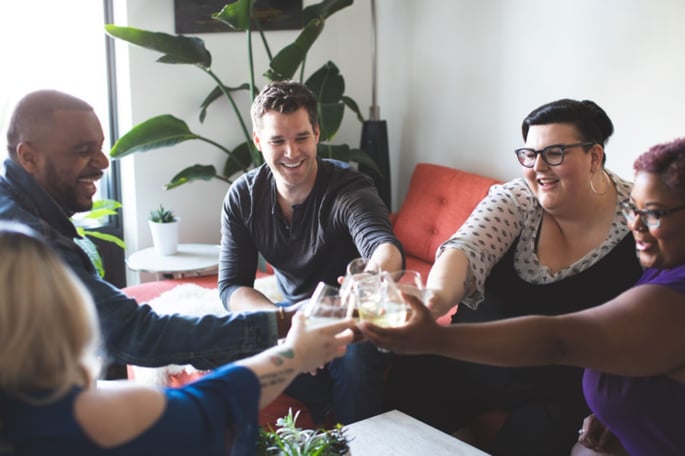How to turn failure into fuel for learning, innovation, and high performance.
4-minute read
On November 10th, 2019, I created a personal Slack channel for my company, LifeLabs Learning, for the purpose of losing 10 pounds by the end of the year. The message:
“This is the 10 lb challenge! It's conceited and hardcore. You ready?”
All together, around 20% of the organization joined the challenge (including one of our CEOs). Every week, members weighed in, starting at 10 lbs (if someone lost 2 lbs, they would weigh in at 8). The goal was to get to zero.
Throughout our time together, we sent notes and pictures of encouragement and shared tips for success. We even named the group The Lightweights.
The result: We all failed.
Since one of our core values at LifeLabs Learning is to Always be Learning, I asked the group why we came up short. Here were some of their hypotheses:
- Doing it during the holidays was wishful thinking on my part.
- I didn't tether the goal to a bigger "why."
- I let myself off the hook way too easily.
- I didn’t hold myself accountable (or ask to be held accountable).
- Doing it while visiting my parents was too much emotional labor.
- I ended up focusing too much on the shiny extrinsic goal.
- I didn’t plan my workouts.
These are all classic mistakes, but there is also something really special about them. What most of these insights have in common is that they take ownership for the failure. This practice goes against our all-too-human tendency to blame mistakes on external events or people. The good news is that research shows that people who take ownership of their mistakes are more likely to learn from them. Perhaps The Lightweights will be able to live up to their name after all.
Why is learning from failure so rare and difficult?
To fail at something is to potentially demonstrate incompetence. The cost, at least in our minds, is often catastrophic (loss of job, relationship, respect, etc.). With an aversion towards loss, we approach the possibility of failure with trepidation (the technical term for this fear is atychiphobia). Not surprisingly, studies show that our bodies register failure as pain.
To make matters worse, failure runs against the grain of our self-esteem. To fail at something is to entertain the possibility that perhaps we’re not as great as we’d like to believe. It’s not by accident that most people tend to attribute success to their efforts, while failure to circumstance. This bias, also known as the Fundamental Attribution Error, often obstructs people from gleaning lessons from their mistakes.
Most work environments don’t help much either. Organizations that are hyper-focused on end results, have low tolerance for experimentation, and provide little time for reflection create hostile conditions for learning.
What can we do to stop failing at failing?
- Normalize it: Researcher Bradley Staats argues that the key to learning from mistakes is to de-stigmatize failure. This means recognizing that failure is a normal (and at times healthy) consequence of working in a complex environment. Everybody poops fails!
At LifeLabs Learning, we normalize failure for our team by explicitly acknowledging the value of failure in our candidate interviews, during onboarding, and in our team meetings. One of our beloved Slack channels is called #faceplants, and it is a spot where we publicly share screw ups, mistakes, and awkward moments in life and at work to laugh at ourselves, learn out loud, and cheer one another on. And in our training, we normalize failure with workshop participants by calling it out as a critical part of the learning cycle.
- Air it out: In Italy there is a saying that a fish on top of the table stinks less than one under it. Put your failures (fish) on top of the proverbial table and let the air circulate. Research shows that learning about other people’s struggles actually improves performances.
At Torres Wine Vineyard, for example, employees are required to inscribe their mistakes in a Black Book. As part of the onboarding process, new recruits are also required to read the book and internalize its message: we make and take ownership of our mistakes.
- Be a failure role model: Airing your mistakes is effective because people often learn best through social modeling. As author Daniel Coyle has written, “No signal is so powerful as a leader who is open about their own mistakes.” In our research on what makes great managers, we’ve seen the same phenomenon. A great example comes from Nobel Laureate Frances Arnold, who tweeted:
“For my first work-related tweet of 2020, I am totally bummed to announce that we have retracted last year's paper on enzymatic synthesis of beta-lactams. The work has not been reproducible. It is painful to admit, but important to do so. I apologize to all. I was a bit busy when this was submitted, and did not do my job well.”
Arnold’s tweet lead to hundreds of comments, including fellow scientists congratulating her for publicly and courageously admitting her mistake.
- Make it safe: Studies show that the best-run hospitals report ten times more errors than their less effective counterparts. The key differentiator of great hospitals (and workplaces) is a climate of psychological safety (i.e. employees can share perspectives and report mistakes without fearing censure or termination). Some of the most effective ways to generate psychological safety are to adopt values that are centered around learning and transparency, implement processes aimed at uncovering errors (e.g. after-action reviews, post mortems, etc.), and teach leaders to acknowledge their own fallibility.
To say there’s value in learning from mistakes is not to fetishize failure but rather to understand that failing is an inevitable part of our fast-paced, ever-changing, and complex work life. Those who are able to succeed at failing will triumph in the Age of Learning we now find ourselves in.
The question is not “Will I fail?,” but rather, “How will I learn from my failures?”
A version of this article was originally published in Fast Company.


